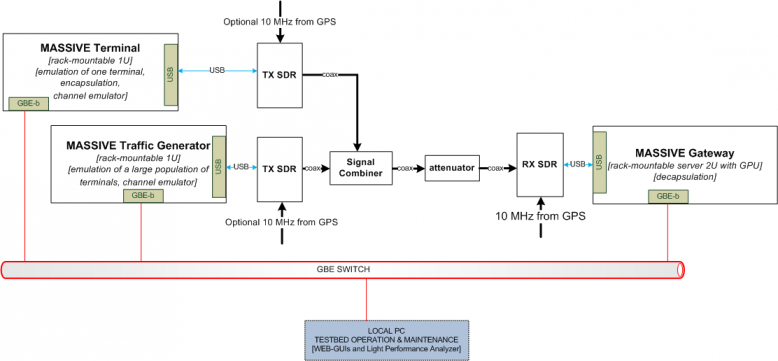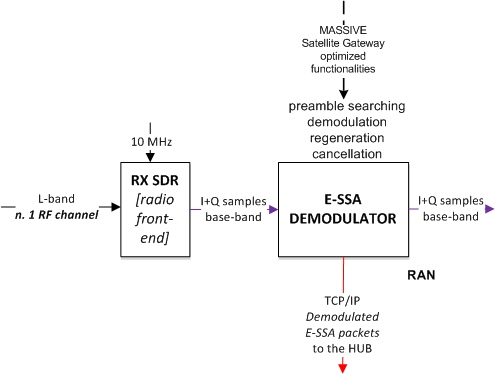
-
StatusCompleted
-
Status date2020-07-10
-
Activity Code6B.030
The MASSIVE project aims to design and develop a Satellite Gateway able to manage a large number of uncoordinated terminals.
The project objectives are in reference to the state-of-the-art protocols and solutions based on the E-SSA protocol. They can be summarized as the following:
- At least 50% improvement in the system overall capacity, or equivalently in the spectral efficiency, allowing the maximization of the number of terminals which can be managed with narrower bandwidths, up to a few millions terminals;
- Counteracting the harmful Doppler effect, enabling the use of terminals operating over LEO (or MEO) satellite constellations;
- Lightening the implementation complexity of the terminals by relaxing requirements over frequency accuracy / phase noise and power even though that may require more processing at the GW side.
The key challenge of the project is being able to design, develop and test in an affordable way the following topics on which the project is focused as an enhancement of already deployed E-SSA protocol:
- Higher order modulation (at least QPSK);
- TDM waveform organization (instead of the CDM foreseen by the S-MIM standard);
- Oversampling reduction;
- Multi-stage despreader approximating MMSE spread spectrum detection and evolved demodulation algorithm;
- Evolved preamble searcher, to cope with the adverse Doppler effect especially in LEO/MEO scenarios;
- Modifications and enhancements of the existing MBI facilities: Traffic Generator, E-SSA Terminal, Channel Emulator, to meet project requirements.
The satellite gateway developed in the frame of MASSIVE is able to manage data traffic generated by a huge number of uncoordinated terminals, giving the way to systems with a dense geographical distribution of users, which fits with the IoT definition.
The gateway can be interfaced with the existing HUB and management systems developed by MBI so as to make effective tests and demonstrations possible.
This factor, together with the eventual installation of the MASSIVE solution in a real gateway made available by a satellite operator to test the prototype with a real satellite constellation, can easily enable MBI and SPENG to validate the prototype even in a real scenario, thus dramatically compressing the time-to-market to launch a cost-effective, attractive and competitive product, especially if a complete Forward and Return link system is developed.
- Increased flexibility of the air-interface, in particular with the development of new spreading techniques which will allow the use of modulation like QPSK, not used so far, since E-SSA is based on BPSK only;
- Better adaptability to narrower bandwidth channels, thanks to the modulation flexibility;
- Study and design of a constant envelope spreading solution which would enable further cost reductions since it would be possible to use non-linear amplifiers for the demodulation as well as simpler transmitters; this solution will be referred to as CPM spreading in order to distinguish it from conventional linear spreading techniques;
- Software development and implementation of the ME-SSA demodulation algorithm which ensures better performance when coupled with the new spreading techniques, TDM and QPSK modulation, as described above;
- Software development and implementation of an evolved preamble searching algorithm, more robust to frequency errors, allowing the correct operation of the system even in scenarios including LEO or MEO satellites.
The architecture of the system to be developed in the project can be derived from an overall and a gateway-focused point of view. The overall physical architecture is the following:

Focusing on the gateway side, the main functionalities and architecture are condensed in the following:

- The first phase includes the definition of use cases, scenarios and requirements and is completed by the solution assessment and the architecture design;
- The detailed design of the solution and SW development phase compose the second phase: during that, the envisaged technical innovations with regard to the state-of-art protocols and solutions are considered in order to enhance the currently available E-SSA test-bed;
- The final phase includes the validation of the solution by means of test procedures to be performed on the MASSIVE test-bed previously set up with the HW included in the MASSIVE kit-list.
The project activities have been completed with the finalization and acceptance of the validation phase.




